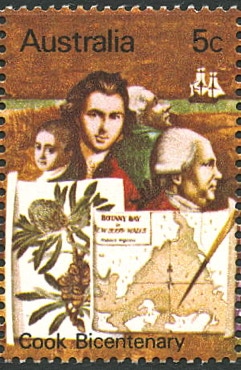Charles Green

Australia, 1970
Charles Green (1734–71) was only a bit-player in the history of British astronomy but makes an appearance on stamps because he was the astronomer on Captain James Cook’s first expedition to the Pacific. Green had learned his trade at Greenwich as assistant to James Bradley, the Astronomer Royal, from 1760 and also assisted Bradley’s successor, Nathaniel Bliss. Green ran the Royal Observatory during the five-month interregnum after Bliss’s untimely death in 1764 until Nevil Maskelyne took up office in 1765.
Green was appointed by the Royal Society as their official astronomer on Cook’s voyage to observe the 1769 transit of Venus from Tahiti. Green already had experience of a transit of Venus, having observed the one of 1761 at Greenwich. A stamp from Tuvalu shows Green and Cook observing the transit, although as there are no known portraits of Green the depiction of him is purely speculative.
Following the transit of Venus, Cook headed south to New Zealand. Here, in 1769 November, Green observed another transit, this time of Mercury, from a place still known as Mercury Bay. Cook then moved on to the east coast of Australia, charting it and making landfall at Botany Bay. Two hundred years later, Australia produced a frieze of five stamps, the fourth of which, called ‘Charting and exploring’, is reproduced above. Charles Green is third from the left, identified by a green coat, and looking skywards. The other characters are, from left, the ship’s artist Sydney Parkinson and the naturalists Joseph Banks and Daniel Solander.
Green never returned from the expedition but died at sea of dysentery contracted when Cook’s ship the Endeavour called at Jakarta for repairs.
For more about Cook, Green, and the transit see James Cook’s 1769 transit of Venus expedition to Tahiti by Wayne Orchiston.
Stanley Gibbons no. 462